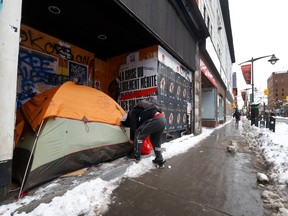The ‘Housing First’ model is a proven, cheaper alternative to impermanent shelters. If you’re a human being, you’re ready to be housed.

Article content
Over the past few years, homeless encampments have become a growing fixture in Canadian communities. They reflect 40 years of poor housing-policy decisions by every level of government. It seems, however, that governments are finally starting to take action.
Unfortunately, much of that action has been far more harmful than housing-focused, often resulting in police sweeps and displacement of people staying in encampments. It’s unclear what the logic behind these evictions is. People still have no place to go when the evictions are done, and instead of having a tiny semblance of stability, are forced to start all over again. A lesser-known, but debilitating result of these sweeps is that people’s ID gets thrown out along with the rest of their belongings. (Try getting income support or applying for housing without ID).
Advertisement 2
Article content
Article content
Forced evictions also cost far more than real solutions. Edmonton spent $1.7 million to evict people from encampments in 2023, with an anticipated increase in 2024. Toronto spent $2 million in 2021 to clear three city parks.
On the more compassionate end of the crisis-response spectrum, governments and community groups are starting to put into place sanctioned encampments, providing access to clean water and toilets, and increasingly developing some kind of temporary structures, staffed by local agencies. While these newer temporary shelter measures are well-intentioned, they are not solutions. What’s more, they still cost more than real solutions that can take less time and create permanent housing stability. In Hamilton, operational costs and capital costs for temporary shelter will be more than $3 million in 2024. Recently 50 shipping containers were built for an encampment in Peterborough, costing just over $1 million.
We are spending millions of dollars on managing homelessness. When you manage homelessness, instead of solving it, there is no end in sight. A shipping container might be better than sleeping on the ground, but it’s not a home.
Advertisement 3
Article content
In contrast, for $1.8 million a year, you could rapidly re-house 100 people using a rent subsidy. For an additional $1 million, you could provide intensive support for the same amount of people, according to local service providers. These supports ensure that people stay housed and don’t re-enter the cycle of homelessness.
Somewhere along the way, as encampments have exploded; shelters are bursting at the seams; and more than 36 per cent of Canadians have been homeless or know someone who has, we lost the plot.
Housing is the solution to homelessness. Canada was a world leader in establishing the evidence base for “Housing First”: a common-sense approach that at its core means all people can be housed successfully when provided the right financial and social support. (Spoiler alert, it’s also significantly cheaper than the alternatives).
The idea that people need to be “housing ready” is not evidence-based at best, and is harmful at worst.
If you’re a human being, you’re ready to be housed. It doesn’t mean you may not need support. It doesn’t mean that your housing looks like an independent apartment in the private market (you might prefer supportive housing, communal housing, roommates, family or other non-market options). And it does not mean that all of your challenges will be solved. It just means that any person will do better when they are not dealing with the fear of being assaulted while sleeping outside; having their belongings stolen in a shelter; or carrying the stress of knowing that tomorrow they’re going to wake up and just try to survive.
Advertisement 4
Article content
Subsidizing rent and providing support does not get us off the hook to build desperately needed non-market housing. But if we don’t get back to a housing-based approach to homelessness, we will see double the amount of homelessness by 2030. It is faster, cheaper and more compassionate to ensure that every person has a home.
So the next time you walk past an encampment or a person experiencing homelessness, remember that we can and have done better in the past. It’s time to return to what we know works: housing-focused solutions instead of expensive measures and emergency responses.
Kaite Burkholder Harris is the Executive Director of the Alliance to End Homelessness Ottawa, an organization that represents more than 75 agencies working to end homelessness together.
Recommended from Editorial
Article content




